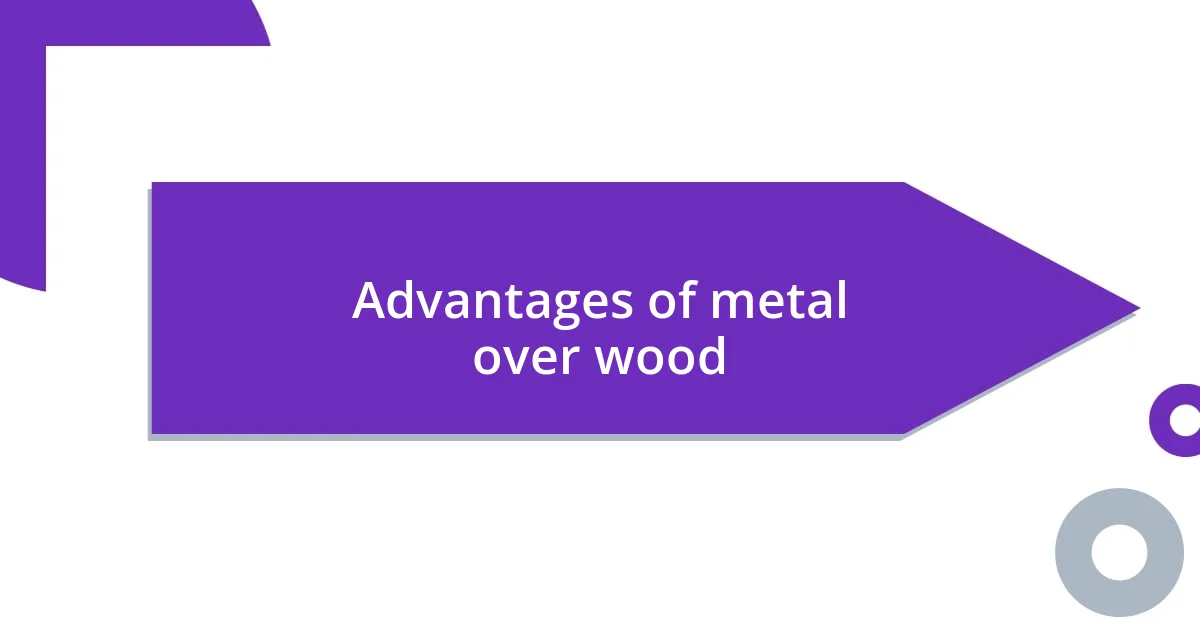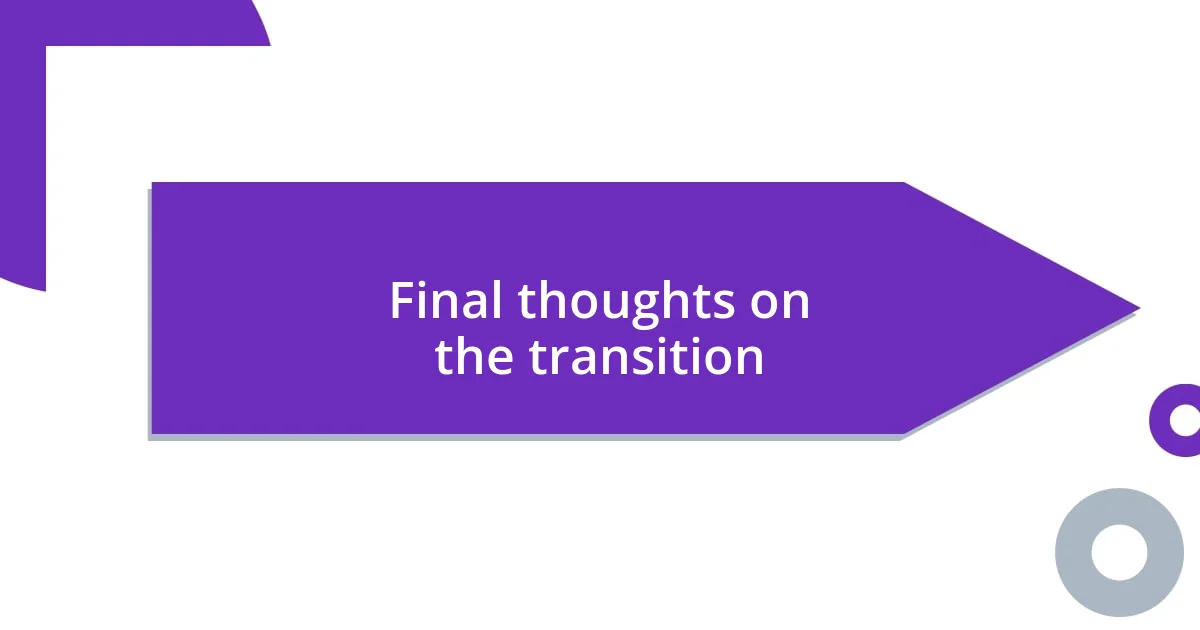Key takeaways:
- Switching from wood to metal enhances durability, requires less maintenance, and offers aesthetic versatility in projects.
- The transition involves challenges like learning new tools and techniques, managing the weight of metal, and understanding specialized finishing processes.
- Safety precautions, including proper PPE and workspace organization, are crucial for effective and safe metalworking practices.

Reasons for switching materials
One major reason I decided to switch from wood to metal was durability. I can still remember that sinking feeling when a beautiful wooden piece I had crafted splintered after just a few seasons. Have you ever faced a similar disappointment? Metal provides strength and longevity that wood, despite its charm, simply can’t match.
Another significant factor was maintenance. With wood, there was a constant need for sanding, sealing, and repainting to keep it looking fresh. I vividly recall spending an entire weekend refinishing a wooden table only to see it weather after a single rainstorm. The shift to metal relieved me of that burden, allowing me to spend more time enjoying my creations rather than working on them.
Lastly, the aesthetic appeal of metal captivated me. I was initially skeptical—could metal really add warmth to my projects? But after creating a few pieces, I found that the sleek, modern look of metal complemented my style perfectly. It’s amazing how a material can transform a space, isn’t it?

Advantages of metal over wood
I found that metal has an impressive weight and stability that wooden furniture simply can’t provide. When I crafted a metal table, the solid feel of it was so reassuring. It didn’t wobble under pressure like some of my wooden counterparts did, which surprised me! This reliability is something I never knew I needed until I experienced it firsthand.
Here are several advantages of metal over wood that I’ve discovered:
- Durability: Metal withstands the test of time and harsh elements better than wood.
- Low Maintenance: I barely have to touch my metal pieces while they remain pristine.
- Fire Resistance: In my workshop, I appreciate that metal doesn’t ignite as easily as wood.
- Sustainability: Metal can often be recycled, making it a more eco-friendly choice in the long run.
- Design Versatility: I love how easy it is to incorporate metal into various styles, from industrial to modern chic.
Switching to metal has broadened my creative options while bringing a sense of ease to my projects.

Challenges of switching to metal
Transitioning to metal from wood brought its own set of challenges that I hadn’t fully anticipated. For instance, I vividly remember the first time I tried to cut metal; the noise was jarring and the sparks nearly sent me jumping back! Metalworking requires different tools and techniques than wood, and mastering those skills felt daunting at first. It’s a learning curve that can be frustrating, but I found that each mishap taught me something new.
Another challenge I faced was the weight of metal. As I started creating larger pieces, I quickly realized how much more difficult it was to maneuver my projects compared to lightweight wood. There were moments when I thought, “Am I strong enough for this?” But I kept pushing through, and I soon developed the necessary physical strength. I can now lift and adjust my creations with much more ease, but it certainly required some perseverance to get to this point.
Lastly, I discovered that finishing metal was a whole different ball game. Unlike wood, which takes stain and varnish easily, metal often requires specialized treatments like powder coating to achieve a desired look. One piece I worked on didn’t turn out as planned after the first finishing attempt—I remember feeling frustrated and defeated. However, that experience taught me the importance of patience and the value of refining my techniques step-by-step.
| Challenge | Detail |
|---|---|
| Cutting Metal | Requires different tools and techniques; initial experiences can be intimidating. |
| Weight | Heavier than wood, making it harder to maneuver larger projects. |
| Finishing | Needs specialized treatments like powder coating, which can complicate the process. |

Tools needed for metalworking
When I first started metalworking, gathering the right tools felt like a huge undertaking. I quickly learned that cutting and shaping metal requires a variety of specific tools, such as a band saw or a plasma cutter, which were completely new to me. I remember feeling overwhelmed standing in the hardware store, staring at options, and thinking, “Which of these will actually make my life easier?”
As I got more comfortable, I discovered the importance of hand tools like files and grinders for fine-tuning my projects. I recall my initial attempts at smoothing sharp edges—oh, what a lesson in patience that was! It was there that I first truly understood how essential a quality angle grinder became in my toolkit—I mean, who doesn’t love the satisfying swiftness of making a rough cut become smooth and precise?
Don’t forget safety gear! I can’t stress enough how crucial it is to wear protective eyewear and gloves while working with metal. The first time I forgot my safety glasses, I was nearly blinded by flying sparks while welding. It was a wake-up call that I will never forget. The right tools not only enhance your work but also keep you safe, and I have come to appreciate every small investment in my workshop, knowing they contribute to both my artistry and well-being.

Techniques for working with metal
One technique I quickly embraced in metalworking was the art of welding. Initially, I approached it with trepidation, watching countless videos and thinking, “Could I ever create a strong bond like that?” My first few attempts were shaky and seemed more like a chaotic mess than a solid seam. However, with practice and a lot of trial and error, I learned how to control the welder, finding a rhythm that felt natural. That moment, when I made my first perfect weld, filled me with pure satisfaction—like unlocking a new level in a game!
Another technique that revolutionized my approach was learning about metal bending. At first, I struggled with the manual tools and often ended up with a warped piece that didn’t resemble my design at all. But then I discovered the magic of bending jigs. Utilizing a jig not only improved the precision of my bends but also made the process feel almost effortless. It’s amazing what the right technique can do; it transformed my projects from flawed to flawless.
Lastly, there’s the concept of metal finishing, which I found to be both an art and a science. The first time I tried sanding down a rough piece of metal, I was dumbfounded at how it kicked up dust and dullness. I remember thinking, why can’t it sparkle like polished wood right from the start? But through experimenting with various grits and polishing compounds, I realized that each step—no matter how tedious—contributed to a stunning final reveal. Patience truly became my ally in this process, and I now get excited about the potential results, knowing that a little effort can yield a gleaming masterpiece.

Safety precautions for metalwork
One of the first safety precautions I always take when metalworking is to ensure the workspace is clear and organized. I once had a close call when I tripped over a stray piece of metal while carrying a sharp tool. That simple incident made me realize how chaos can lead to accidents; I learned that keeping everything in its place not only makes me more efficient but also significantly reduces the risk of injury.
Wearing the proper personal protective equipment (PPE) is another non-negotiable aspect of metalwork safety for me. I remember the discomfort of having slag land on my arm during a first-time welding project; it was a painful reminder that protective clothing isn’t just an option—it’s essential. I now ensure that my gloves, flame-resistant jacket, and face shield are always on hand and that they fit properly. It’s about creating a barrier between me and the potential dangers lurking in my workspace.
Furthermore, I always make it a point to understand the specific hazards associated with my tools. For instance, while I was getting familiar with the plasma cutter, I initially underestimated how much noise it produced and how important hearing protection would be. Once I started using earmuffs, not only did it save my ears, but it also allowed me to focus better on what I was doing. Each discovery I made reinforced the idea that knowledge combined with the right precautions truly enhances my safety while working with metal. Isn’t it fascinating how awareness can empower us to create without fear?

Final thoughts on the transition
Shifting from wood to metal was a journey filled with both excitement and challenges. I remember standing in my workshop, surrounded by my new metal tools, feeling a mix of fear and exhilaration. Was I really ready to dive into this new world? Each project pushed me closer to realizing my capabilities, proving that discomfort can lead to growth.
As I navigated through this transition, I found myself constantly redefining what I thought was possible. There were moments of frustration, especially when things didn’t go as planned, but those were also times of discovery. For instance, a failed weld turned into a lesson about patience and perseverance. It begged the question: How can failure be so valuable? Through these ups and downs, I cultivated resilience that reverberates through every piece I create.
Ultimately, this transition has transformed not just my skillset, but the way I view challenges in life. Metalworking taught me that crafting is more than just a task; it’s a personal journey filled with emotional highs and lows. Isn’t it incredible how a simple change in material can lead to richer experiences and deeper connections to the craft? Embracing metal has not only expanded my artistic expression but has also let me explore new facets of myself along the way.














